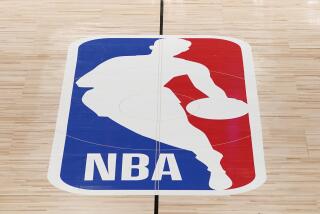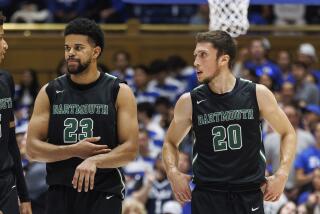NBA’s Tough Drug Policy Didn’t Make All the Problems Disappear
- Share via
Though it has the toughest drug policy in major professional sports, the National Basketball Assn. found that problems among its players didn’t disappear after the no-nonsense program was adopted.
Announced jointly in October of 1983 by the NBA Players’ Assn. and then-Commissioner Larry O’Brien, the league’s plan gives players two chances to voluntarily come forward for treatment of drug problems.
The first time a player is treated, he is paid his full salary during rehabilitation; the second time, he is suspended without pay; and the third time, he can be banned indefinitely from the NBA, with the possibility of reinstatement in two years.
“Our goal is rehabilitation,” Commissioner David Stern said. “It would be easy to say that we should give the druggies--as some commentators call them--one shot and they’re out. We take a more compassionate view, but we also want to send the message that our patience has some limits.”
Former All-Star John Drew was banned last month from the NBA because of what the league said was his three-time involvement with cocaine.
However, Tom Rasmussen of Salt Lake City, Drew’s lawyer, said Drew’s stay in a drug treatment center wasn’t linked to cocaine, but was mandated by a judge after Drew was charged with writing bad checks.
“The league is not making an example of John Drew,” said Larry Fleisher, general counsel of the NBA Players Assn. “We have a collective bargaining agreement and he fit the category of those who had had too many bites of the apple. He has come forward not once, not twice, but three times. Our position is clear. We have examined the evidence and there’s nothing we can do under the agreement.”
The NBA has had to deal with three problem areas connected with the drug program:
--Wiping the slate clean for drug offenses before the October 1983 agreement was reached. Micheal Ray Richardson of New Jersey, Quintin Dailey of Chicago and John Lucas of Houston got what the public believed were two “free” drug relapses.
--Quick rehabilitations. Some of the players who were admitted for treatment, most recently Richardson and Walter Davis of Phoenix, were in hospitals only a matter of weeks before returning to action. Fans ridiculed the league for allowing the players back so soon.
--So-called last chances. Is it realistic to expect a player who had two strikes against him to come forward a third time, knowing he faced permanent expulsion?
Stern said the drug policy’s amnesty clause, which forgives problems before the October 1983 program started are ignored, “is our most difficult public relations problem. But we have an agreement with the players’ association that is being lived up to.”
Now that Richardson, Dailey and Lucas have had their two extra chances, “we’re not kidding them.”
“They are out if it happens again. But we had to temper that seriousness with compassion,” Stern said.
Concerning what some regard as quick rehabilitation, Stern said, “Anyone who pronounces a player as cured after a month is presenting the facts wrong. The players’ association and the league do not do that. We recognize the problem is chronic.”
“Hospital treatment is only part of the drug rehabilitation program,” Fleisher said. “Aftercare is a major part of rehabilitation and part of the aftercare therapy is returning to work. Aftercare without working is counter-productive. That’s true whether you’re a basketball player or a shopkeeper.”
Russell Granik, the NBA’s executive vice president, said when a player is reluctant to turn himself in a third time ,”a player’s interests become less important and the interest of the league’s well-being more important.”
If a player who has been through rehabilitation misses a game, for whatever reason, he can be called by the league to undergo a drug test. If he does not show up for the test, the NBA would regard that as a relapse, Stern said.
More to Read
Go beyond the scoreboard
Get the latest on L.A.'s teams in the daily Sports Report newsletter.
You may occasionally receive promotional content from the Los Angeles Times.










